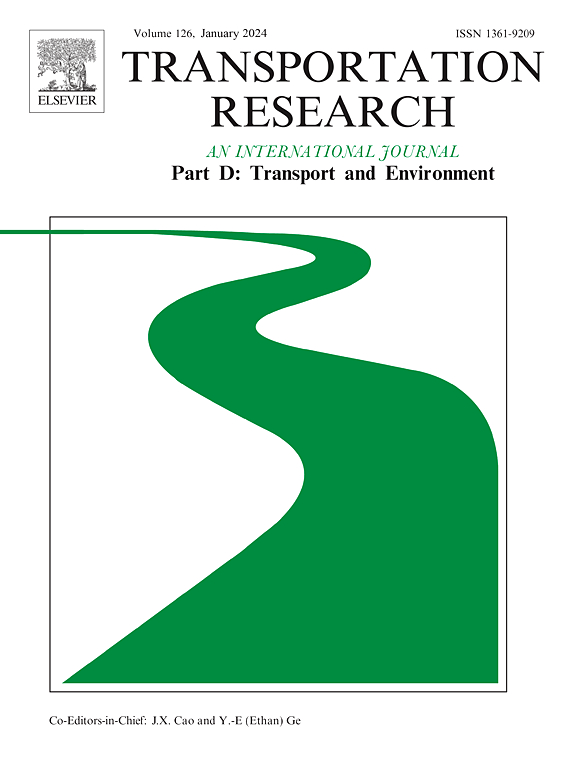Assessing spatial access disparities to critical facilities during hurricanes in Florida
IF 7.7
1区 工程技术
Q1 ENVIRONMENTAL STUDIES
Transportation Research Part D-transport and Environment
Pub Date : 2025-08-13
DOI:10.1016/j.trd.2025.104957
引用次数: 0
Abstract
This study investigates equitable access to critical facilities including gas stations, hotels, and shelters during hurricane evacuations in Florida. Using facility location data from the Homeland Infrastructure Foundation-Level Data and Google Places API, alongside hurricane risk data from FEMA’s National Risk Index, we develop an Evacuation Resource Index (ERI). The ERI incorporates facility proximity, calculated using a network-based approach, and population distribution to assess the adequacy of resources during evacuations. Univariate analysis using Local Moran’s I—a Local Indicator of Spatial Association—highlights significant statewide disparities in resource access, while the corresponding bivariate analysis pinpoints vulnerability hotspots where low ERI and high hurricane risk converge. It is also found that these hotspots are disproportionately populated by socially vulnerable communities characterized by factors such as low incomes, limited vehicle access, linguistic isolation, and older age. Furthermore, these areas exhibit high income inequality, as indicated by their Gini index. This research underscores the urgent need for equitable disaster preparedness strategies that prioritize vulnerable populations residing in high-risk areas. By addressing these disparities, we can enhance evacuation effectiveness and foster community resilience in the face of hurricanes.
评估佛罗里达州飓风期间关键设施的空间出入差异
本研究调查了佛罗里达州在飓风疏散期间对加油站、酒店和避难所等关键设施的公平获取。利用来自国土基础设施基金会级数据和谷歌地点API的设施位置数据,以及来自联邦应急管理局国家风险指数的飓风风险数据,我们开发了一个疏散资源指数(ERI)。ERI综合了设施邻近性(使用基于网络的方法计算)和人口分布,以评估疏散期间资源的充分性。使用Local Moran 's i(空间关联的本地指标)进行的单变量分析强调了资源获取在全州范围内的显著差异,而相应的双变量分析指出了低ERI和高飓风风险交汇的脆弱性热点。研究还发现,这些热点地区不成比例地居住着社会弱势社区,其特点是收入低、交通不便、语言不通和年龄较大。此外,这些地区表现出高度的收入不平等,正如其基尼指数所显示的那样。这项研究强调,迫切需要制定公平的备灾战略,优先考虑居住在高风险地区的弱势群体。通过解决这些差异,我们可以提高疏散效率,培养社区应对飓风的韧性。
本文章由计算机程序翻译,如有差异,请以英文原文为准。
求助全文
约1分钟内获得全文
求助全文
来源期刊
CiteScore
14.40
自引率
9.20%
发文量
314
审稿时长
39 days
期刊介绍:
Transportation Research Part D: Transport and Environment focuses on original research exploring the environmental impacts of transportation, policy responses to these impacts, and their implications for transportation system design, planning, and management. The journal comprehensively covers the interaction between transportation and the environment, ranging from local effects on specific geographical areas to global implications such as natural resource depletion and atmospheric pollution.
We welcome research papers across all transportation modes, including maritime, air, and land transportation, assessing their environmental impacts broadly. Papers addressing both mobile aspects and transportation infrastructure are considered. The journal prioritizes empirical findings and policy responses of regulatory, planning, technical, or fiscal nature. Articles are policy-driven, accessible, and applicable to readers from diverse disciplines, emphasizing relevance and practicality. We encourage interdisciplinary submissions and welcome contributions from economically developing and advanced countries alike, reflecting our international orientation.

 求助内容:
求助内容: 应助结果提醒方式:
应助结果提醒方式:


